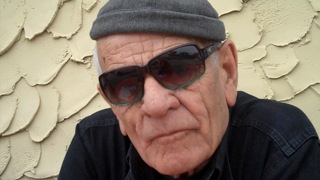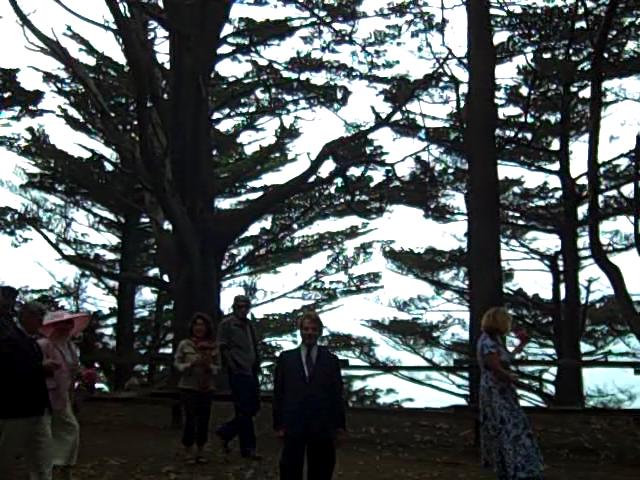
To read his new stories, please click here

Created by June Morrall

Story by Gray Gardener
Email Gray: [email protected]
June; Thanks for your article on Artichokes, I discovered The Artichoke when I moved back to California in 1953, and finished High School in Woodland. My mother discovered them and how to prepare them,
Later, in 1957 we moved back to Missouri, and artichokes were just starting to show up in the markets there.People would sneak over to my mother and ask: “What are those?”.
Later in 1967 when I moved to El Granada, I was completely surprised that I was surrounded by artichokes, and of a size I never imagined.I soon learned different ways to prepare them,and seldom had a meal, when I was home,without them.In fact sometimes, a couple of Artichokes,and a couple of bottles of wine were my dinner (Corky’s Store was way too close).
Later, in 1977 I lived near Sidney, Ohio,in the country, and my lady, and I. had a really large garden.At this time I really fell in-love with County Fairs, and in Ohio, county had a fair.
I used to sit on the fence, and watch the boy on the farm next door work his border collie each day,and later saw him win the competition at the Shelby County Fair.Somewhere along here I became obcessed with growing Artichokes in Shelby County (Probably the most “artichoke climate and soil” in the country), having the choke documented by the “County Agent”, and then entering it in the County Fair, in hopes they couldn’t ID it, let alone judge it.”
I sent for information on growing artichokes, designed a “Plastic Greenhouse”, with spray to re-create coastside fog & shade, and was all ready to go,when my Girlfriend ran off and joined the carnival. (There hangs another story.) and my whole life and project fell apart.
I still love Artichokes and miss Abalone,more than I can describe- Take care-
Gray
Excelsior Springs
Story by Deb Wong
Email Deb [[email protected]]
I am halfway through Mikie’s book, “Searching for Anna.”. Read it during work today. Interesting “small town” details here: The book mentions many familiar names and places. Some of the people I recognize as customers during the time I worked at Longs. I remember that Mikie’s husband Charles Calvert also oftencame into the gallery with his watercolors to be framed. Michael has a piece of artwork that was given to him by the previous owner of Mikie and Charles’ house, Howard Gilligan, who painted the portrait of Anna for the book. I have attached a scan of the painting that Michael kept, which is on an envelope
around a postage stamp of a bald eagle. 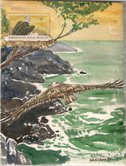
It is reminiscent of my envelope drawings.
Michael also shot Mikie’s wedding to Charles in 1998. A Greek Church
wedding, in San Francisco, on Brotherhood Way..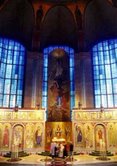
Mikie was Michael’s next-door neighbor when he, Lorna & Kaitlyn lived in Montara. She taught Kaitlyn piano. Attached is the only shot that we have of that wedding (back in the olden days – you know – before digital – Michael would give the wedding couple their negatives. He didn’t keep them, as many professional wedding photographers did). You can’t really see Mikie & Charles, who are a tiny blur, but the stained glass windows are brilliant. I posted it on the wedding website.
————————————–
Story by Walter Ruhlmann
I haven’t told you that my parents used to live in California in the late 50s early 60s.
The thing is my father was a cook on board of a ship during his state service which he did in the navy – young men didn’t have the choice, until 1998, we all had to register and be conscripted – my brother and I also went into the navy. At the time whan my father did his, it lasted 12 months – mine was due for 10 months, I did 3 and went off sick with 7 months left.
He embarked on a ship to NYc and because of a brzakge at some point on board, they had to stay 6 whole months in NYC. He fell in love with the States.
Later, my father went back to the US on his own first working at the Beverly Hilton in LA, then went back to France to marry my mother and adopt my elder brother and they all flew to LA, then moved to San Francisco. They left because mum was homesick and heard about deaths in both families which she couldn’t bear being far away from. So they all came back in 63 – as far as I remember. I was born 11 years later as you know.
I’m sending you a paper clip from an American cuisine critique and another one in French when dad received a distinction in the late 70s just to show you who my dad is (was – he is retired now of course) on the photo, next to him is mum. I had just been born at the time.
=============================================
“1955: Story by Mike Jackson
Cuisine a ‘Way of Life’ for Experienced Chef, Disciple of Escoffier
Cook’s Night In. I always wear tennis shoes when turning out Jell-O. Gives you chance to jump back when the stuff splashes, Escoffier, the great French chef, worked in a black frock coat. These differences in our clothing caused me to wonder how other chefs were going about their kitchen craft these days. Thought it was time to talk with one. We could swap trade secrets.
Man I discussed dish doings with was Michel Ruhlmann, chef of the Escoffier Room at the Beverly Hilton Hotel. Ruhlman is one of the 65 specialists who feed 3000 to 4000 daily in the hotel’s three dining rooms, banquet halls and through room service. They are all under the direction of Gabriel Comte, chief chef.
Since its opening in August 1955, with a $100 per plate feast, The Escoffier Room has been a gathering place for gourmets. Ruhlmann presides over its kitchen with a retinue of three cooks, one pantry boy. He shows up for work at 4, serves the first meal at 7. He wears white jacket and pants, puts on his high bonnet only for special occasions.
Ruhlmann is in his mid-30s, a serious type with brown eyes and hair and a lithe way of walking. He likes to cook over charcoal, doesn’t go in for timers, thermometers or gadgets. He knows when a dish is ready without the need to look at a dial.
It’s a nice life. But he hopes, soon to return to his native Normandy village of Forge les Eaux. One thing that draws him back is a wonderful dessert called Drouillon, apples wrapped in pastry and served with cheese.
“Here,” he said, “everyone is in such a hurry. There’s no time for small pleasures and conversation. Here, no one walks. In France, I do not need a car.
Back home, Ruhlman walks to the butcher, chats with neighbors along the way, meets with the farmers when they bring their vegetable carts into town.
“Every week we had picnics,” he aid. “Always in the evening is singing and dancing. We enjoy life.”
“LOCAL GOURMETS, says Rurhlmann, are most likely to order Dover Sole Michel, duck or soufflés. Men prefer snails, filet or New York cut steaks and Cherries Jubilee. Women go for lobster, chicken, French pastry. We eat less fish than do the French and more sweets. The French finish their meals with cheese and a glass of red wine.
” All Ruhlmann’s attitudes, like those of any chef, are deeply influenced by George Auguste Escoffier. Escoffier was called “The king of chefs and the chef of kings.” Nobody knows the brave man who first ate an oyster, but King Edward VII was the first to have a go at frogs’ legs. Escoffier served them up in a wine boullion covered with champagne aspic. It was only one of hundred dishes he created.
“More important than Escoffier’s innovations in kitchen technique and his creations, was his complete break with the past. Until 1880, ladies did not dine in public. When Charles Ritz made the Grande Hotel de Monte Carlo the most luxurious restaurant in the world, it was Escoffier who prepared special dishes for women, worked with silversmiths and the Waterford crystal factory to set a table that equaled that of Europe’s finest homes.
“NOW, EVERY top restaurant reflects the Escoffier touch. There is hardly a sauce or specialty that cannot be traced to him. Escoffier, himself, would probably pass up them all. He ate simply, on soup with rice and fresh fruit.
“I have a feeling Escoffier would’ve been elated by my Jell-O. But he died in 1935, when all could cook was marshmallows over a campfire.”
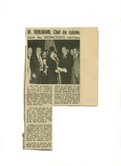
————————————
Walter Ruhlmann is a teacher and editor living in France.
To check out his website, please click here
[Image below: Deb & Mike Wong]
Email Deb ([email protected])
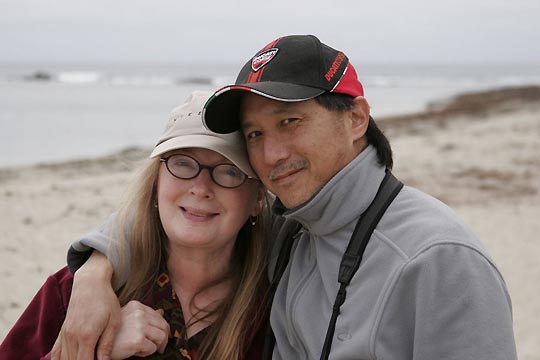
On Saturday, Michael’s daughter Kaitlyn brought by a Fathers Day gift for her dad. Since she couldn’t take him out to breakfast, she brought a book for him, instead – “Searching for Anna”. I had been reading your blogs, and mentioned the book to Michael. He was surprised, and said that he didn’t know that “Mikie” as he calls her, had lost a child. He told his daughter about the book several weeks ago (she and her mom know Michaele, too), and Kaitlyn bought a copy. Since Michael doesn’t read books often, I will be reading it today when waiting at the hospital. Anna would be 2 years older than my daughter Kelly, who is now 37. I know that there will be tears, so have brought lots of tissues. That has got to be the worst – not knowing. Leaves an open wound that can never know closure. Sorry if this sounds too sad. I have great faith that we will be reunited with our loved ones when we leave our bodies. It’s just now that is hard to get through.
You take care, too, but just wanted to know that one one way or another, your blogs are being read, and inspire folks.
Story from John Vonderlin
Email John ([email protected])
Board of Trade Created HMB 1905
Hi June,
The most interesting thing to me about this article from the August 22nd, 1905 issue of “The Call,” is the list of movers and shakers of Halfmoon Bay and the district. I wonder if any of those letterheads still exist? Might be interesting to see how this Chamber of Commerce-type organization did with its first big effort. Enjoy. John
HALFMOON BAY FOR PROGRESS
CITIZENS ORGANIZE A BOARD OF TRADE TO ADVANCE THE INTERESTS OF THE SECTION
BUSINESS MEN IN LINE
ENTIRE DISTRICT UPON WHICH TOWN DEPENDS FOR PROSPERITY WILL BE GIVEN ATTENTION
HALFMOON BAY Aug. 21.— This
city has given another evidence of its
progress. The coming of the electric
railway, the laying out of a new sum
mer resort and the establishment of a
town bank have been followed by the
organization of the Board of Trade of
Halfmoon Bay. This body is a practi-
cal, working association of the leading
citizens here.
They are determined to advance and
advertise the interests not only of
Halfmoon Bay, but of the entire dis-
trict upon, which this town depends for
its prosperity. As a preliminary meas-
ure in this direction, the Board of
Trade has under consideration the the purchase of 10,000 letter heads and envelopes, appropriately marked, to distinguish the town.
The board has elected the following
officers to serve for the first term:
President, Joseph F. Francis; first vice
president, C. F. Wlthrow; second vice
president, A.. E. Case; secretary, A. A.
Lawson; treasurer. J. Hall Lewis of the
Bank of Halfmoon Bay. The executive
committee, upon which will devolve
much of the. active work of the organization is as follows:Y. B. Sanders, C. W. Borden, Henry Levy and W. V.
Francis.
The success of this effort of the peo-
ple of Halfmoon Bay to improve the
condition of their town is assured by
the following membership in the
Board of Trade, which comprises the
leading merchants, business and com-
mercial men and citizens here: Robert
I. Knapp, Lester J. Skidmore, Joseph
Debenedetti, C. F. Withrow, W. V.
Francis, C.W. Borden, H. G. Knapp.
A. A. Lawson, Jay C. Powers, J. C.Meckelson, Joseph Rue, John Pitcher,A. E. Case, A. T. Gilcrest, Albert Ritz, Joseph F. Francis, C.P. Mosconl, Y. B.Sanders, Henry Levy, James Seymour, Edward S. Gonzales, Thomas F. Quinlan, J. V. Azevedo, William Pringle, J. H. Lewis, H.E. Griffiths, J. C. Perielra, Dr. G. S. Holllster, and W. A. Simmons.
=========
H=


